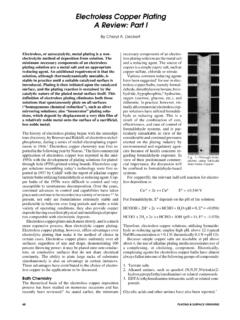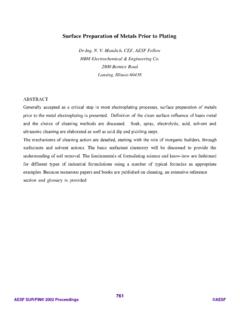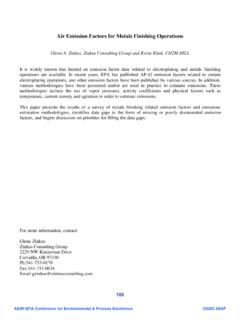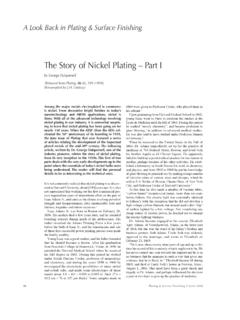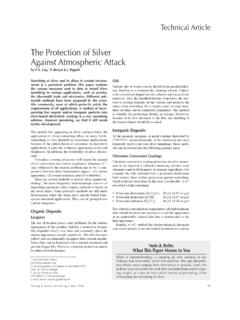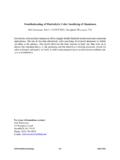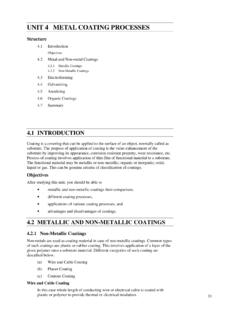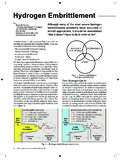Transcription of Cyanide Copper Plating - STERC
1 36 Plating & SURFACE FINISHINGA pplicationsElectroplated Copper from Cyanide -based Plating solutionshas long been used both as an engineering or decorativefinish, and as an undercoat for other plated metals. Thesecyanide Copper solutions are used to plate on a wide varietyof base materials. These include steels, zinc alloys, aluminumalloys, Copper alloys, magnesium alloys, nickel alloys, andlead alloys. An important property of Copper from Cyanide -based systems is its ability to adhere well to these properties of electroplated Copper deposits that are ofinterest for various applications include: (a) soft, ductiledeposits; (b) it is easily buffed; (c) good electrical conductiv-ity; (d) good solderability; (e) stop-off properties on steel forselective case-hardening processes .
2 (f) decorative finishescan be plated bright with proprietary additives, or givenattractive antique finishes such as oxides or patinas, (g) Copper plate from Cyanide Plating solutions protects acid-sensitive base metals from attack by subsequent acid platingsolutions; and (h) it plates easily with other an undercoat for subsequent nickel-and-chromium ornickel-and-brass electroplates, Cyanide Copper is applied inthe decorative or functional Plating of zinc alloy castings usedfor trim or hardware in the automotive, appliance, electrical,plumbing fixtures, household goods and other is also used as an undercoat over Copper and nickelalloys for subsequent nickel-and-gold, silver, or nickel-and-silver electroplates in the electronic connector and soft Copper is much easier to polish by buffing thansteel.
3 Cyanide Copper plated deposits can be plated on roughersteels and then buffed to produce high-luster finishes whenused as an undercoat for a minimum thickness of subsequentbright nickel a decorative finish without subsequent electroplates ofother metals, Copper Cyanide deposits are used on cabinethardware, hinges, drawer pulls, knobs and brackets. Theseare sometimes given post-treatments to color or darken thedeposits, which are then highlighted by mechanical finishingor selective buffing to produce antique finishes. Similarfinishes are found on fireplace trim, lamps, lighting fixturesand other household items with or without the antique post-treatment.
4 For these applications, clear lacquers are used overthe Copper plate to preserve the color and functional applications for Cyanide Copper as a finishinclude Plating the steel clamps on battery jumper cables, aswell as other electrical connectors and fittings, alligator clips,etc. Aluminum buss bars have been plated with cyanidecopper to provide low contact resistance for bolted connec-tions. Lead sporting ammunition is plated with heavy copperdeposits to prevent lead fouling of gun barrels, protect theprojectile shape, and produce desired expansion characteris-tics on relatively new application with which most everyonehas daily contact is found in coinage, where Cyanide copperis used to plate zinc alloy penny blanks by the millions!
5 Theproperties of the unbrightened Cyanide Copper deposits aresuch that the coining operation produces a very bright appear-ance. The plated penny has surprised many critics with itsresistance to corrosion during the rigors of circulation. Copper is used in many other Plating applications in whichcyanide solutions are used very little. Electroforming, with afew exceptions, is usually done from acid Copper wiring boards utilize electroless Copper , acid copperand pyrophosphate Copper , with the exception of one majormanufacturer who used Cyanide Copper successfully on spe-cial boards for many years.
6 Copper plate is also used as a drylubricant in some wire drawing processes , but an immersioncopper process from acid solutions is most often Copper deposits are also used in coating steelitems such as BB shot for appearance, lubricity, and tempo-rary rust prevention; on welding rods for low contact resis-tance; and on other steel parts, sometimes just for coloridentification is electroplated primarily from Cyanide , acid sulfateor pyrophosphate Plating solutions; in the , pyrophos-phate is the least used. Other bath formulations have beenpublished or advertised but have not reached sufficient com-mercial volume to be or Acid?
7 While it is not the intent here to go into all the factors thatinfluence the choice of which Copper Plating solution to use,a list of the major factors would include:1. Acid Copper Plating solutions attack most basis metalsand/or produce immersion deposits with poor adhesion,especially on steel, zinc and aluminum alloy acid Copper is to be plated over these metals, Cyanide Copper Plating is used as an undercoat to producegood Deposits from Cyanide Plating solutions exhibit much lessdeposit thickness variations (better throwing power) overthe surface of a part.
8 The more complicated the shape of apart, the more significant this property Cyanide is, of course, highly poisonous and must behandled with great care. Additionally, limitations on al-lowable Cyanide in wastewaters are very stringent andcomplete destruction methods are required in most , it should be recognized that Cyanide destructiontechnology is well established and proven Proprietary bright acid Copper solutions are capable of ahigh degree of leveling , the smoothing of roughsurfaces with increased Plating thickness). Cyanide cop- Cyanide Copper PlatingJack HornerNovember 199937per solutions generally produce the opposite effect, espe-cially on rougher surfaces; however, periodic currentreversal (PR) cycles and/or pulse Plating with some pro-prietary additives can provide significant Copper Plating Solutions ComponentsCopper Cyanide , the source of Copper in solution, is notsoluble in water.
9 It requires either sodium or potassiumcyanide to form the soluble complexes to put it into , an excess of the alkali metal Cyanide , over theamount necessary to form the complexes, is needed forsound, good quality deposits and good anode corrosion. Thisexcess amount is referred to as free Cyanide or uncomplexed Cyanide . Caustic soda (sodium hydroxide) orcaustic potash (potassium hydroxide) is added to: (1) in-crease conductivity, (2) reduce electrochemical attack onsteel anode containers or any wetted exposed steel, and (3)reduce the decomposition of Cyanide .
10 Caustic additions alsohave an influence on anode films. Rochelle salts or propri-etary additives are commonly used. They provide a finer-grained Copper deposit, as well as improving anode corro-sion. In addition, they limit the effects of detrimental other chemical found in Cyanide Copper Plating solu-tions is the alkali metal carbonate. A small amount (2 to 4 oz/gal) is sometimes added to new solutions to provide solutionbuffering in the cathode film and improved conductivity. Inany case, carbonates are formed naturally in the solution withtime, due to the decomposition of Cyanide and absorption ofcarbon dioxide from the air.
